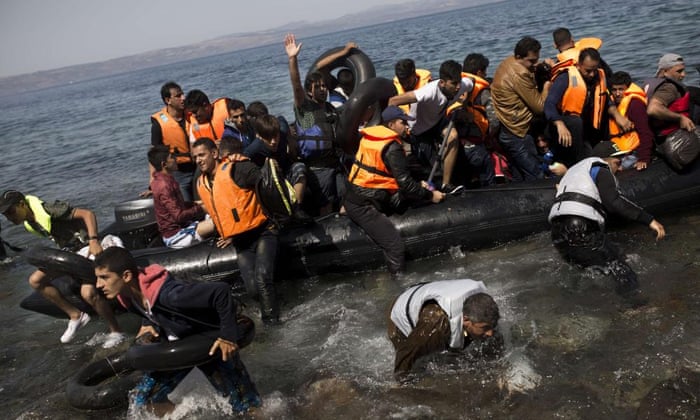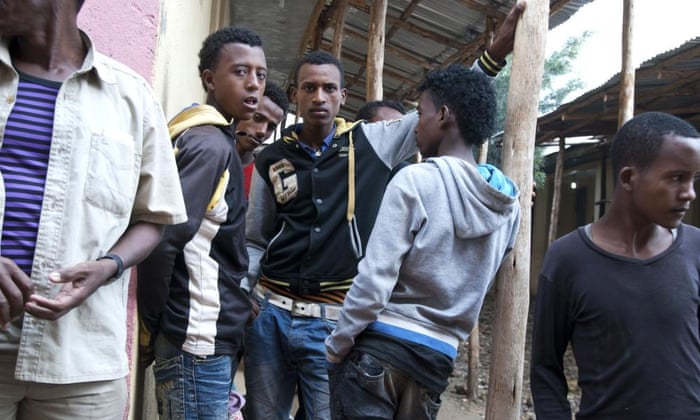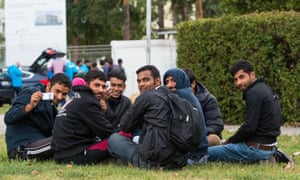Refugee crisis: apart from Syrians, who is travelling to Europe?
2015-09-11 16:17:39 Written by Patrick Kingsley Migration correspondent Published in English Articles Read 2935 times

Refugees arrive on the shores of the Greek island of Lesbos after crossing from Turkey in a dinghy. Photograph: Angelos Tzortzinis/AFP/Getty Images
Syrians account for 50% of the 380,000 refugees who had arrived in Europe after crossing the Mediterranean by early September, but several other nationalities are turning up in large numbers. According to UN figures, 75% of the total refugees hail from countries in the midst of armed conflict or humanitarian crises. So apart from Syria, where are they coming from, why did they leave, and how are they reaching Europe?
Afghans – 13%
Why are they leaving?
According to the Afghan government, 80% of the country is not safe. That is because extremist groups such as the Taliban and Islamic State’s local affiliate are waging insurgencies in many provinces. Civilians are at risk from frequent bomb attacks, while many individuals are fleeing because they have received specific threats from extremists.
Yama Nayab, who travelled with his two small children through the Balkans earlier this summer, left because he was attacked by extremists angry with him for working as a surgeon with the Afghan army. “Why are you working for the government?” one assailant allegedly told him, before stabbing him four times near his heart. “Here in Afghanistan, the Americans and the pagans made a government – and you are working for that government,” he was told.
The route taken
Some are going via Pakistan, but most are walking over the border into Iran, a trek that takes up to two days. Then they drive to Iran’s border with Turkey, where they cross again on foot, in another laborious hike. If spotted by border guards, the walkers face trouble. “The Iranians fired on us near the border and killed two people,” said Rahman Niazi, 18, a computer science student who reached Europe this year.
Once in Turkey, Afghans take a day’s bus journey to the same Aegean ports many Syrians are using to reach Greece. Some pay €10,000 (£7,250) to smugglers to organise each stage of their journey. Others move on a more ad-hoc basis.
It's not at war, but up to 3% of its people have fled. What is going on in Eritrea?
Read more
Eritreans – 8%
Why are they leaving?
Eritrea is Africa’s version of North Korea, a country with no constitution, court system, elections or free press. Outside of the metropolitan elite, most Eritreans must submit to a form of forced labour – lifelong military conscripts who have no choice about where they live or work. Any dissenters are sent to prison without any judicial recourse.
“Eritrea has become an earthly hell, an earthly inferno for its people, and that’s why they are taking such huge risks to their personal lives to escape the situation,” said Andebrhan Welde Giorgis, the former head of Eritrea’s central bank and ex-ambassador to the EU. “It’s become unliveable.”
The route taken
Most walk over the border into Ethiopia or Sudan, a dangerous first step that sees some shot by border guards or kidnapped for ransom by smugglers. If they make it to the Sudanese capital, Khartoum, they then being a brutal journey through the Sahara to Libya. To cross the desert, smugglers cram about 30 people into the back of pick-up trucks. Many refugees die of dehydration en route and trucks often go missing during sandstorms.
The trauma does not end in Libya. Most people carry no cash, in case it is stolen, and do not pay upfront in case the smuggler leaves without them. So on arrival in the town of Ajdabiya, in north-east Libya, they are held in smugglers’ compounds and usually tortured until their families send the $2,000 (£1,300) required for payment. This process is often repeated at least once – for a similar ransom – at a location further along the Libyan coast, before the refugees are permitted to board a ramshackle boat to Italy from one of the country’s western ports.
Eritrean refugees at the Shire refugee camp in Ethiopia
Eritrean refugees at the Shire refugee camp in Ethiopia. Photograph: Vincent Defait/AFP/Getty Images
Nigerians – 4%
Why are they leaving?
Boko Haram, the Islamist extremist group, continues to fight an insurgency in northern Nigeria, killing and kidnapping locals and forcing many to flee. “Boko Haram is everywhere, killing innocent people every day,” said Vincent Collins, 24, who described himself asa victim of the conflict. “Bombing, fighting, every day. It’s so terrible.”
Other Nigerians are escaping from poverty. Many have a story like that of Paul Ohioyah, a plumber and part-time pastor who tried to reach Europe earlier this summer. He said life was untenable in Nigeria because he would only get two plumbing jobs each month. “So before you’ve got another customer, you’ve had to spend what you earned the last time,” said Ohioyah, who is still on the coast of north Africa after unsuccessfully attempting to reach Europe by boat. “It’s better that I die here than go back to Nigeria.”
The route taken
Most head over the northern border to Niger and take public buses to the city of Agadez, a smuggling hub on the cusp of the Sahara. From here, they join the smuggling trail to Libya, experiencing similar horrors to Eritreans crossing the desert from Sudan – kidnap, torture and death by dehydration. Smugglers take them to Sabha, in south-west Libya, for about £150. From there, for a similar fee, different smugglers transport them to ports on Libya’s western coast.
Somalians – 3%
Why are they leaving?
As in Afghanistan and Pakistan, Islamist insurgents, including al-Shabaab, are fighting an insurgency, with civilians caught in the middle. Eissa Abdirahman, 18, a footballer with one of the country’s second-tier teams, said he left because he was attacked by al-Shabaab militants and told to stop playing football. “They put a gun to my head and kicked me,” said Abdirahman, shortly after being rescued from the Mediterranean earlier this month. “They said: ‘If you don’t stop playing football, we will kill you.’”
The route taken
One popular route is through Kenya, Uganda and south Sudan. Then people head north to Khartoum, where most follow the same route and adversities as the Eritreans. But a smattering of refugees now follow the Balkan route – into Kenya, fly to Iran, then cross the Iranian-Turkish border, before heading by boat to Greek islands.
Refugees from Pakistan sitting on the grass at a reception centre for asylum seekers in Eisenhüttenstadt, eastern Germany. Photograph: Patrick Pleul/dpa/Corbis
Pakistanis – 3%
Why are they leaving?
More than 1.2 million Pakistanis have been displaced by insurgencies in north-west Pakistan, according to the UN, and by some estimates, more than 20,000 civilians have been killed. The well-documented attack on schoolgirl Malala Yousafzai and the December 2014 massacre of 100 schoolchildren in Peshawar are prominent examples of the threats ordinary people face from extremists.
The route taken
Like Afghans, Pakistanis walk into Iran, then take a bus to the border with Turkey, where they cross again on foot. They then pick up the Balkan route that begins on the Turkish coast.
Iraqis – 3%
Why are they leaving?
Vast swaths of Iraq, including its second city, Mosul, have recently been conquered by Isis, worsening a nightmare that began with the west’s invasion of the country in 2003. “They force people to pray by force, they use us as their human shields,” said Ahmad, a civil servant who fled Mosul a month ago, and recently reached central Europe. “They’ve also murdered many people, and detained many others before killing them.”
The route taken
Iraq borders Turkey, so most reach Turkey by land and then take boats to Greek islands.
Sudanese – 2%
Why are they leaving?
Civil wars in the country’s Darfur and Kordofan regions continue to displace civilians. Mohamed Abdallah, 21, from Darfur, said he was forced to flee aged 12, when government militias destroyed his village, killed many of the local people, and raped his sisters. “There is a war in my country, there’s no security, no equality, no freedom,” he said. He tried to reach Europe earlier this summer, after the war spread into south Sudan, where he had first fled to.
From Syria to Sudan: how do you count the dead?
Read more
Darfur is still unsafe – a Human Rights Watch report recently alleged that the Sudanese government had carried out many killings and mass-rapes of civilians in dozens of towns.
The route taken
Sudanese refugees can easily reach their capital, Khartoum, from where they are smuggled to Libya, and then across the Mediterranean to Italy. Like Eritreans and Somalians, many die of thirst in the desert and fall victim to extortion and torture by smugglers in Libya.
Statistical source: the UN refugee agency.




















